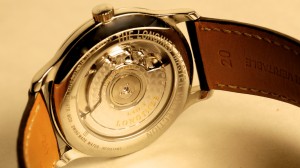 One of the most frequently asked questions we get at our watch counters is about the difference between quartz and mechanical movements. The movement of a watch is what drives the hands and can be one of the most important factors in determining the cost of a watch.
One of the most frequently asked questions we get at our watch counters is about the difference between quartz and mechanical movements. The movement of a watch is what drives the hands and can be one of the most important factors in determining the cost of a watch.
We’re going to get technical for a moment here, so please bear with us:
- Quartz movements are mostly electronic systems: a piece of the mineral quartz is powered by a battery and vibrates approximately 33 times per second. The vibrations are translated into impulses by a microchip, which drives an electronic motor that powers the hands.
- Mechanical movements are powered by a wound spring, and as that spring releases energy, gears are turned which move the hands of the watch. The spring is either hand-wound (known as a manual movement) or self-wound (known as an automatic movement, see below).
- Automatic movements are the most popular kind of mechanical movements. A centrally mounted rotor is activated by the motion of the wearer’s wrist, winding the mainspring and providing energy to the watch. Automatic watches do not need to be manually wound, unless the watch has not been worn for an extended period.
So what does all this mean? Outside of the fact that quartz watches will need the batteries replaced every few years, here are a few other major differences:
- Accuracy: Quartz watches are highly accurate, with even the cheapest movements being accurate to within a half second per day. Even the best mechanical movements are off by two to three seconds per day.
- Cost: Although the first quartz watches from the late 1960’s were more expensive than their mechanical counterparts, mass production quickly drove down prices. Except for rare exceptions, quartz movements are less expensive than their mechanical counterparts.
- Service: Quartz watches will need to have their batteries replaced (typically on an annual basis) and the case back may need to be resealed when the watch is opened to maintain water resistance. Mechanical and automatic watches have no battery, but require maintenance every 5 to 10 years depending on use.
- Longevity: A quartz watch can last the user for 20 – 30 years, as the electronic components of the watch will eventually wear out. A well-maintained mechanical watch will outlive the original purchaser. High-end mechanical watches can be heirloom pieces, passed down from generation to generation.
If you’re looking for the most accurate timepiece that never needs to be wound, then a watch with a quartz movement is likely your best bet. On the other hand, if you want a watch that can be passed down to the next generation, or if you appreciate the fine craftsmanship that it takes to build a traditional timepiece, a mechanical movement might be right for you.
At Stones Jewelry, many of our entry-level luxury watches use quartz movements, including Pulsar, Seiko, and ESQ. Hamilton, Longines and Ebel offer a few quartz watches, but the majority of these lines consist of mechanical movements.
Got more questions about what makes a watch tick? Feel free to stop by our store, or contact us at anytime.







